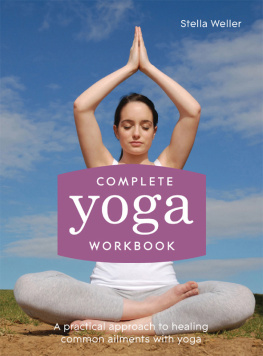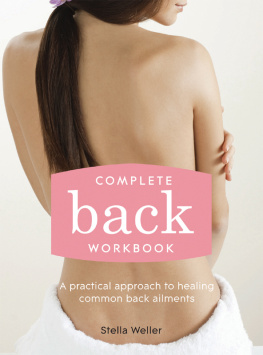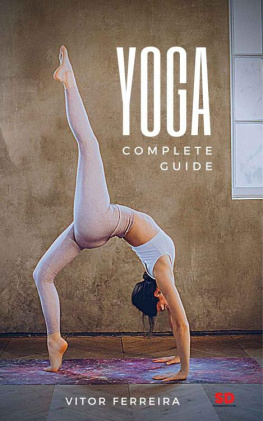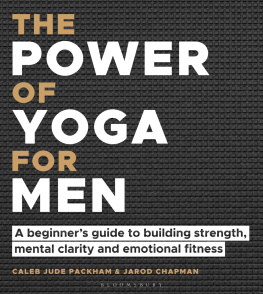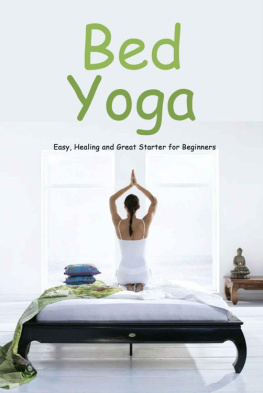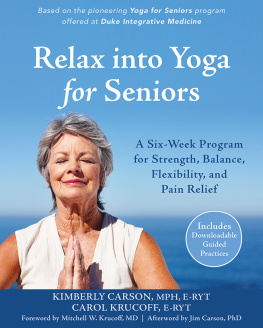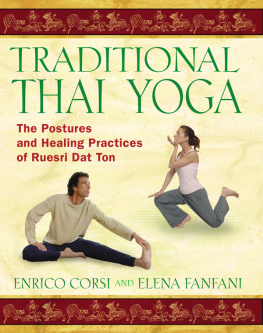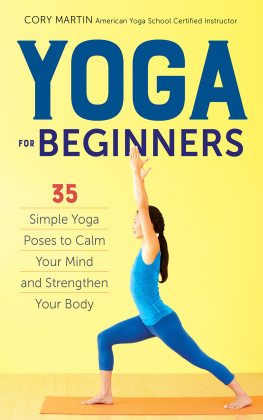


A practical approach to healing common ailments with yoga
Stella Weller

CONTENTS
INTRODUCTION
A doctor sets a broken bone or brings together the edges of a wound and secures them with sutures. Another doctor prescribes a medicine to halt the progression of a dreaded disease, but it is the body, not the doctor, that brings about the actual healing.
Regardless of the cause of damage, healing follows a predictable course that may be divided into four phases: vascular response, inflammation, proliferation and reconstruction. Within seconds of an injury, the body begins the first of these phases to control bleeding and limit the spread of infection. Blood vessels constrict, clotting begins and various protective and healing processes are set in motion. The other three phases follow the first in a beautifully synchronized fashion until the structure and function of the damaged tissues have been repaired and restored, and the equilibrium of the healing system has been re-established.
The healing system is composed of all the bodys systems (such as the immune and nervous systems) and also of physiological components such as our mind and our breath. And when treatments work (such as those prescribed by a doctor), it is because they activate the healing mechanisms that are within us.
When we are injured or experience a breakdown in health, collaboration between us and our health-care provider (doctor or other qualified professional) usually offers the best chances of a satisfactory outcome. Therefore, let us not underestimate what we, as individuals, can do to contribute to this working relationship. For no matter where we are, we have within us (although often underutilized), natural resources that can promote health and healing: our body, our mind and our breath. These three components of the whole person have been part of the focus of the centuries-old discipline of yoga, and Complete Yoga Workbook will show you how to make them work for you safely, efficiently and enjoyably.
More than 5000 years ago in India, a philosophy known as yoga came into being. The word yoga comes from Sanskrit and has various meanings, including yoke and unity. It implies an integration of every aspect of the human being into a harmonious whole.
The principles of yoga were passed by word of mouth from master to student. About 3000 years later, an Indian sage named Patanjali finally recorded these teachings in a now-classical work called Yoga Sutras. This guidebook provided the framework for modern-day yoga practice.
The book has something to offer everyone, whatever their age or sex. Yoga can be very beneficial for pregnant women, but they should first seek permission from their doctor.
Health educators and fitness instructors will also find it a useful resource. And even if you are not recovering from an illness or injury, you can use the exercises and procedures to enhance your performance in sports, professional dancing and other activities, or to acquire stamina for increased productivity and fulfillment in any endeavour. Enjoy the exercises and savour their resulting health benefits.

Tree of yoga
In ancient times, yoga was compared to a tree with six branches: bhakti, hatha, jana, karma, raja and tantra. Each branch represented a particular approach to life. Most people in industrialized societies worldwide now practise hatha yoga. Ha means sun and tha means moon.
Hatha yoga, then, may be considered a union of opposites to create balance. The system of hatha yoga (which will be referred to simply as yoga from now on) may be divided, for convenience, into five parts: asanas, pranayama, meditative practices, relaxation practices and cleansing practices.
1. Asanas
Generally regarded as physical exercises, yoga asanas are more accurately poses comfortably held. They involve movements or series of movements by which muscle groups are put into action and energized. The manner in which this is done is economical: high levels of physical performance can be achieved with a minimal expenditure of energy.
Each asana involves the contraction of some muscle groups and the relaxation of their opposing muscles. Done slowly and with control, it heightens ones awareness of faulty postural habits and unnecessary muscle tensions.
Once the posture (exercise) has been completed, the practitioner is encouraged to visualize the beneficial effects, at first in the muscles and other structures on the outside of the body and then, in time, in the internal organs and tissues.
Each posture brings into action all the muscles and joints of a given part of the body. Consequently, muscles that tend to atrophy (waste away) through lack of regular exercise are now conditioned and receive an improved blood supply, while joints move freely as they lose their stiffness.
In many of the asanas, the vertebral column (spine) is subjected to gentle traction, thus releasing pressure on spinal discs and nerves. Increased spinal flexibility can lead to a reduction of pain and other discomforts, and posture is also improved.
The synchronized breathing required in the execution of all the exercises ensures good oxygen delivery to the working muscles. The full focusing of attention on the performance of the exercises has a tranquillizing effect on the nervous system, leading to a sense of calm and control.
These combined benefits, through regular practice over time, result in a strengthening of mind and body and a maintaining of wellness. Should health be disrupted, however, regular practice of the asanas will greatly contribute to reinforcing your healing system to help bring about recovery.
2. Pranayama
Exercises in voluntary breath control are collectively referred to as pranayama. They take advantage of the fact that the respiratory (breathing) system is the only body system that is both involuntary and voluntary.
The primary function of the respiratory system is to provide oxygen for the bodys metabolic needs and to remove carbon dioxide from the tissues. Respiration works very closely with circulation. It is through the circulation that tissues receive oxygen and nutrients, and the body is protected from agents of disease.
Because of the close collaboration between the respiratory and circulatory systems, techniques that train you to breathe efficiently will undoubtedly help you to function at your best when you are well. And when you are ill, they will maximize your chances of a satisfactory recovery by boosting your healing system.
The connection between breathing and feelings is undeniable. It is most noticeable when feelings are intense. In anger, for instance, breathing tends to be rapid and shallow, and in grief it may sound like a sob. In anxiety, particularly if it is marked, can be so rapid as to border on hyperventilation, with symptoms such as heart palpitations and feelings of lightheadedness.
Next page
